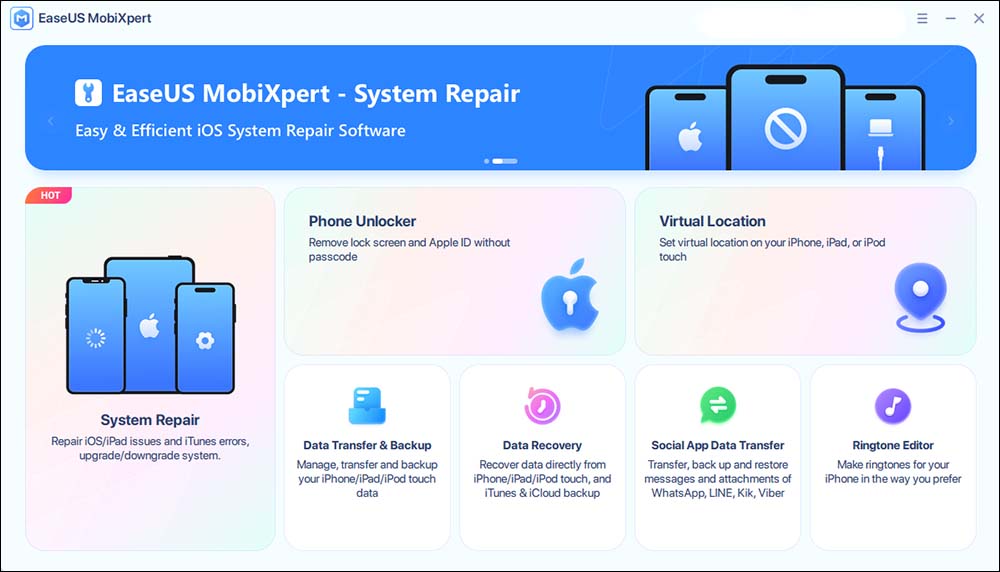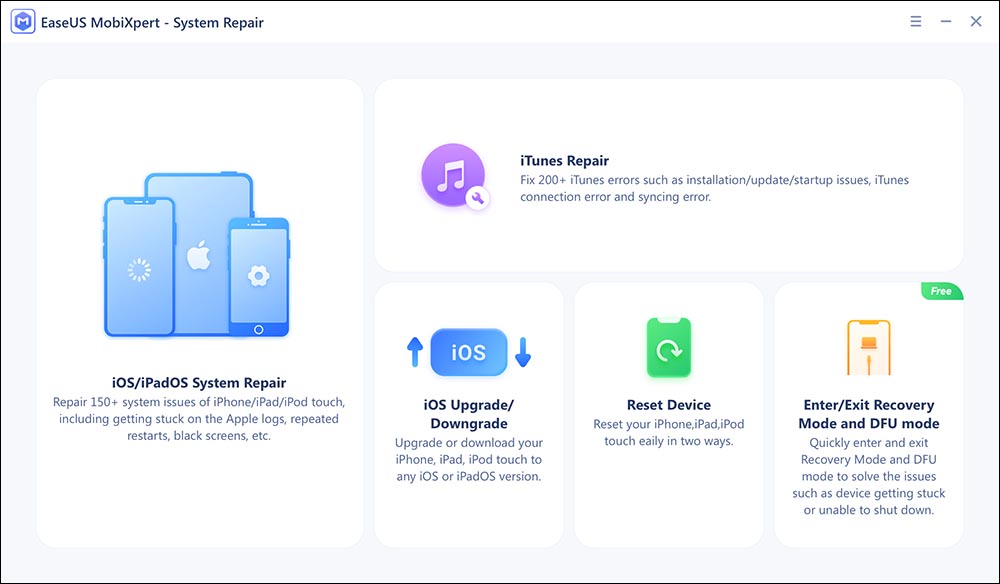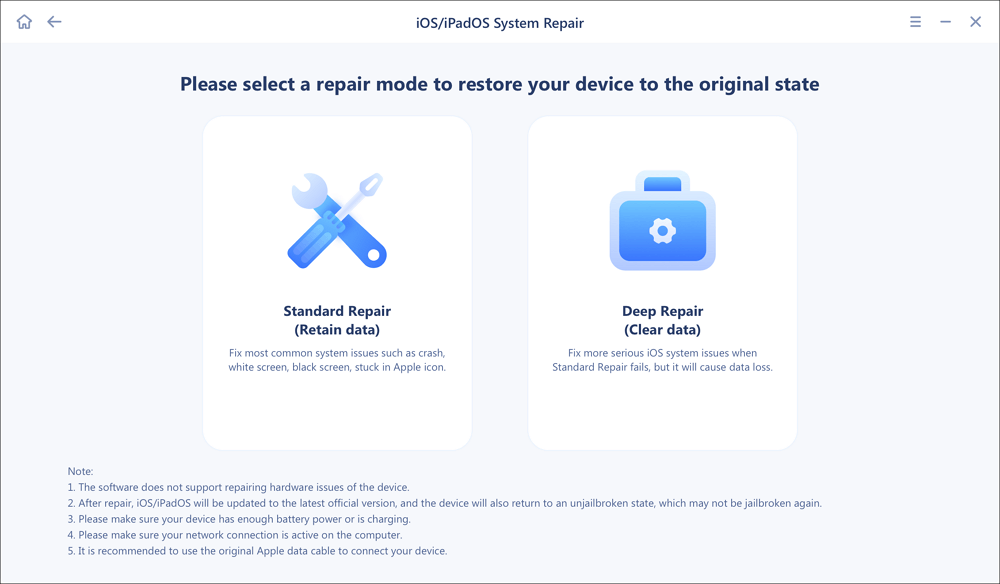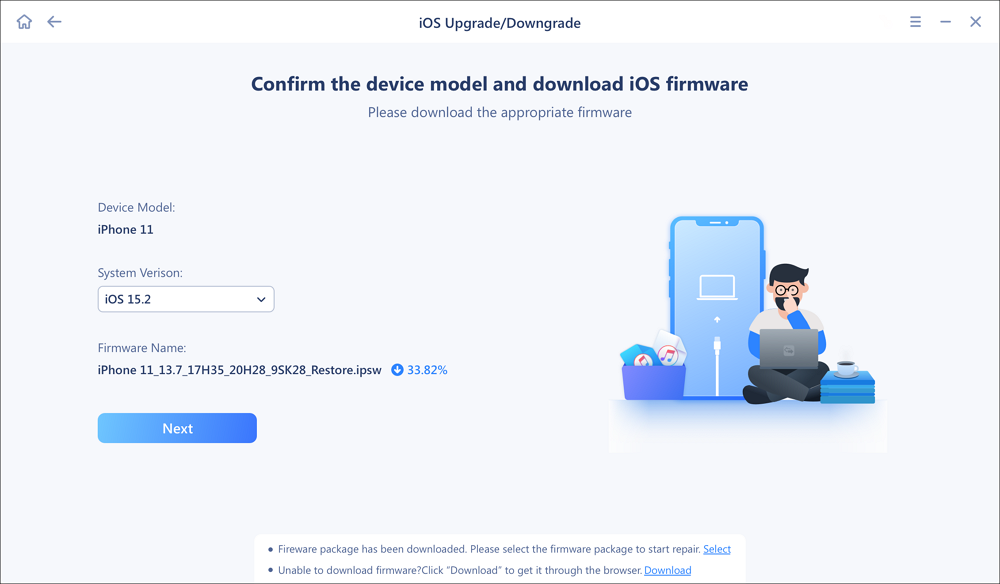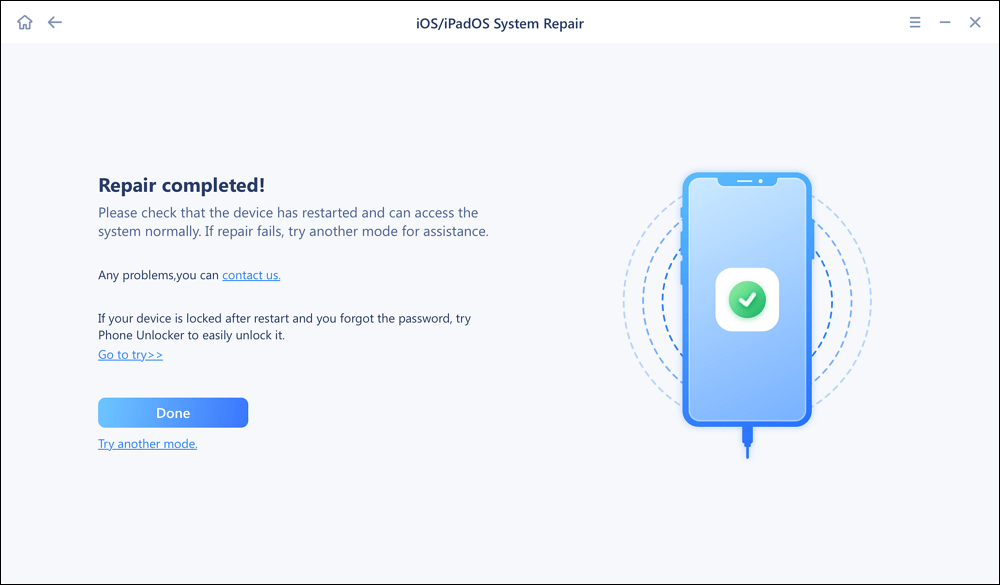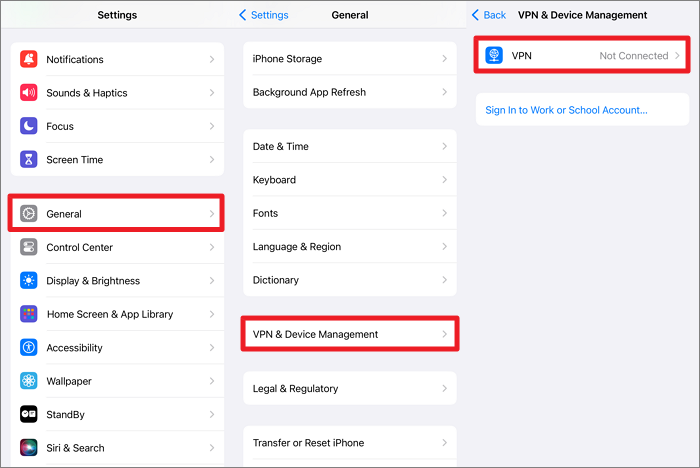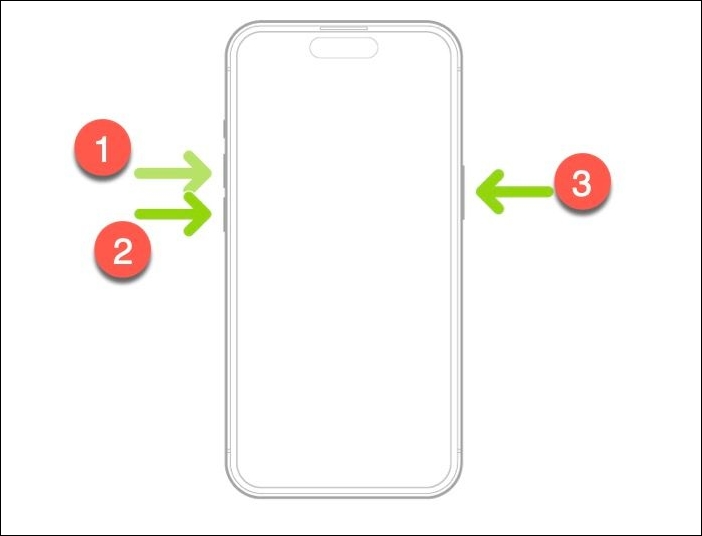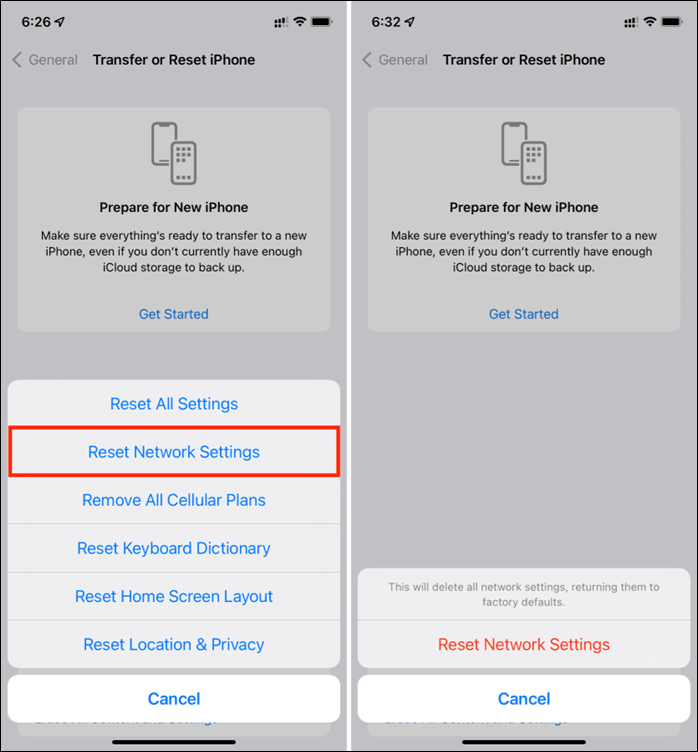Quick Navigation:
- If an error occurred while checking for a software update, it is usually caused by network issues, system bugs, server problems, or device settings. > Why iPhone Unable to Check for iOS 26 Update
- For system glitches, you can apply professional repair tools like EaseUS MobiXpert, which offers a reliable, user-friendly solution to repair system issues without data loss and update your iPhone or iPad to iOS 26 successfully. > Repair System Issues When iPhone Update Failed
- You can also resolve the update failure issue with other methods, like ensuring a stable internet connection, freeing up storage, and updating via a computer. > How to Fix Unable to Check for iOS 26 Update Error
Updating to the latest iOS version is crucial for experiencing new features, enhanced security, and improved performance. However, many users attempting to upgrade to iOS 26 encounter the Unable to Check for Update error. This issue prevents the device from connecting to Apple's servers to verify and download the update file, leaving the user's iPhone stuck on checking for updates. In this guide, we will explore the common reasons behind this issue and provide practical, step-by-step solutions to help you update your iPhone or iPad to iOS 26 successfully.
Why Does My iPhone Say Unable to Check for Update on iOS 26?
Understanding why "Unable to Check for Update" appears is the first step to resolving the issue. Several factors can cause the iOS 26 update to fail, ranging from network issues to software glitches. Here are the most common reasons why your iPhone is unable to check for updates for iOS 26:
![unable-to-check-for-update.png]()
- Apple server issues: Sometimes, Apple's update servers are overloaded or down, preventing devices from checking for updates.
- Poor internet connection: An internet connection is required to download the update files from Apple's servers and verify the update before installation. An unstable or weak Wi-Fi connection can block the update process.
- Device incompatibility: Older iPhones that do not support iOS 26 will not see the update options.
- Software bugs or glitches: Bugs in iOS 26 or iOS 26 Beta can cause the device to get stuck checking for updates.
- Incorrect data and time settings: A misconfigured system time can cause verification failures.
- Insufficient storage space: If you don't have enough storage space, the IPSW file will not be downloaded successfully, which prevents your iPhone from updating.
Repair System Issues When iPhone Update Failed [iOS 26 Supported]
From the above, it's clear that software glitches and system errors often play a significant role in blocking the update process. One highly effective solution is EaseUS MobiXpert, a user-friendly tool designed to fix various iOS system problems, including update failures on iOS 26. This software can repair your iPhone's operating system by addressing glitches, corrupted files, or stuck processes. With EaseUS MobiXpert, you can restore your device to normal operation quickly and safely, ensuring that your iPhone is ready to download and install the latest iOS version without hassle.
Key Features of EaseUS MobiXpert:
- It can resolve problems like update failures, devices stuck on the Apple logo, recovery mode loops, black screens, and more.
- It repairs system issues without erasing your personal data or settings.
- It offers both Standard Mode (which preserves your data) and Advanced Mode (for deeper system repair when needed).
- It can upgrade your iOS system to the latest version successfully without data loss.
Step 1. Launch EaseUS MobiXpert on your computer, choose "System Repair" from the Home page.
![MobiXpert hompage]()
Step 2. Then, choose "iOS/iPadOS System Repair" from the new screen.
![ios system repair]()
Step 3. Connect your iPhone or iPad to the computer and choose "Standard Repair." If you want a thorough repair, you can choose "Deep Repair."
![select repair mode]()
Step 4. Confirm your device model and click "Next" to move on. Then, EaseUS MobiXpert will download a firmware for you, which will take a while. If you have installed a firmware before using this software, you can directly click "Verify" to continue.
![verify firmware]()
Step 5. Then, click "Repair Now" to start the repair process. After the repair completes, you can check your device and restart it for use.
9 Fixes for Unable to Check for iOS 26 Update Error
Fix 1. Check Apple's System Status
When Apple's update servers are down or experiencing high traffic, your iPhone won't be able to connect to check for new updates. This is a common cause of the "Unable to Check for Update" error, especially during the initial rollout of a major iOS version, such as iOS 26. Checking Apple's System Status page will quickly tell you if there is a known issue affecting software updates.
Step 1. Open a web browser on your iPhone or computer and navigate to Apple's System Status page.
Step 2. Look for the entry labeled Apple Store, iCloud, or Software Update.
Step 3. If it shows a green dot, the servers are functioning normally. If you see a yellow or red indicator, it means there is an outage or maintenance ongoing.
Step 4. If there is an issue, wait until Apple resolves it, then try checking for the update again.
Fix 2. Check Time & Date Settings
iPhone relies on accurate date and time information to communicate securely with Apple's servers when checking for updates. If your device's date or time is incorrect or out of sync, it can prevent the update process from starting. Ensuring that your iPhone is set to update its date and time automatically often resolves this issue quickly.
Go to Settings > General > Data & Time. Toggle Set Automatically to ON.
![set-date-and-time-to-automatically-1.png]()
If it's already on, toggle it off and back on to refresh the setting. Then, try checking for the update again.
Fix 3. Switch to a Stable Wi-Fi Network
A stable and strong internet connection is essential for your iPhone to check for and download updates. Switching to a reliable Wi-Fi network, preferably your home or office network, can eliminate connectivity issues that block the update check.
Go to Settings > Wi-Fi. Tap the i icon next to the current network and select Forget This Network if it's unstable.
![wi-fi-button-off.png]()
Select a stable Wi-Fi network from the list and enter the password to establish a connection.
Fix 4. Confirm iPhone Compatibility
Not all iPhone models support the latest iOS updates. If your device is too old, it simply won't show the option to update to iOS 26. Before spending time troubleshooting, it's important to confirm whether your iPhone is compatible with the new update. The following is the iOS 26 supported devices list.
![ios-26-compatible-devices.png]()
Fix 5. Disable VPN
VPNs and proxy servers can interfere with your iPhone's ability to connect securely to Apple's update servers. While VPNs are useful for privacy and security, they sometimes cause connectivity issues during system updates. Temporarily turning off any VPN connections can help your device communicate properly and check for the update.
Open Settings on your iPhone. Go to General > VPN & Device Management. If a VPN is active, toggle it off to disconnect.
![disable-the-vpn-from-iphone-1.png]()
Fix 6. Restart Your iPhone
Many software glitches and temporary bugs can be resolved with a simple restart. Restarting your iPhone clears background processes and refreshes system resources, which often resolves issues that prevent the update check.
Restart your iPhone (for iPhone X and later):
Step 1. Press and hold the side button and either volume button until the power off slider appears.
Step 2. Drag the slider to turn off your iPhone.
Step 3. Wait about 30 seconds, then press and hold the side button until the Apple logo appears.
Force Restart your iPhone (for iPhone 8 and later):
Step 1. Press and quickly release the Volume Up button.
Step 2. Press and quickly release the Volume Down button.
Step 3. Press and hold the Side (power) button until the screen goes black and the Apple logo appears.
Step 4. Release the Side button when you see the Apple logo, and your iPhone will restart.
![force-restart-iphone-13.jpg]()
Fix 7. Reset Network Settings
Network settings can sometimes become corrupted or misconfigured, causing your iPhone to fail when trying to connect to Apple's servers. Resetting network settings restores all Wi-Fi, cellular, and VPN configurations to their defaults, which often resolves connectivity issues affecting update checks.
Step 1. Go to Settings > General > Transfer or Reset iPhone > Reset > Reset Network Settings.
![reset-network-settings-iphone-ios.png]()
Step 2. Enter your passcode if prompted and confirm the reset. Then, your iPhone will restart.
Step 3. Reconnect to your Wi-Fi network and try checking for the update again.
Fix 8. Free Up Storage Space
iOS updates require a significant amount of free storage to download and install. If your iPhone is running low on space, it may not be able to check or download the update properly. Freeing up storage by deleting unused apps, photos, or other large files can clear the way for a successful update.
Step 1. Open Settings > General > iPhone Storage.
![iphone-storage.jpg]()
Step 2. Review the list of apps and how much space they use.
Step 3. Delete or offload apps and files you no longer need.
Step 4. Aim to free at least 5GB of space for the update.
Step 5. After freeing space, go to Settings > General > Software Update and try again.
Fix 9. Update iPhone/iPad via iTunes
If over-the-air updates continue to fail, updating your iPhone through a computer can bypass many common issues. Using iTunes (on Windows or macOS Mojave and earlier) or Finder (macOS Catalina and later) allows you to download and install the update manually, often resolving errors caused by device or network glitches.
Step 1. Connect your iPhone to a Mac or PC using a Lightning cable.
Step 2. On macOS Catalina or later, open Finder; on Windows or macOS Mojave and earlier, open iTunes.
Step 3. Select your iPhone when it appears in the app.
Step 4. Click Check for Update.
Step 5. Follow the on-screen instructions to download and install iOS 26. Wait for the update to complete and then restart your device.
Conclusion
In conclusion, encountering the "Unable to Check for Update" error on iOS 26 can be frustrating, but it is often caused by common and fixable issues such as server outages, network problems, or device settings. By systematically applying the fixes outlined in this guide, you can resolve most update errors quickly and safely. Remember to ensure your iPhone is compatible with iOS 26 and that you have sufficient storage and a stable internet connection before attempting an update. If all else fails, professional repair tools such as EaseUS MobiXpert or Apple Support can provide additional assistance.
FAQs
1. Why is iOS 26 not showing up?
iOS 26 may not appear if your device is not supported, or if you are not enrolled in the Apple Developer Program but only in the Public Beta program. The public beta for iOS 26 has not yet been released; only developer beta users currently have access.
2. Why does my iPhone keep saying unable to check for an update?
This error usually occurs due to a weak or unstable internet connection, Apple's update servers being down or overloaded, software glitches, incorrect date and time settings, or device incompatibility with iOS 26.
3. Why is my iPhone not verifying the update?
Verification can fail if your Wi-Fi connection is unstable or the update file is corrupted. You can resolve the issue by restarting the iPhone, resetting the network settings, and re-downloading the update. Additionally, you can update your iPhone via iTunes or Finder.
NEW
HOT

